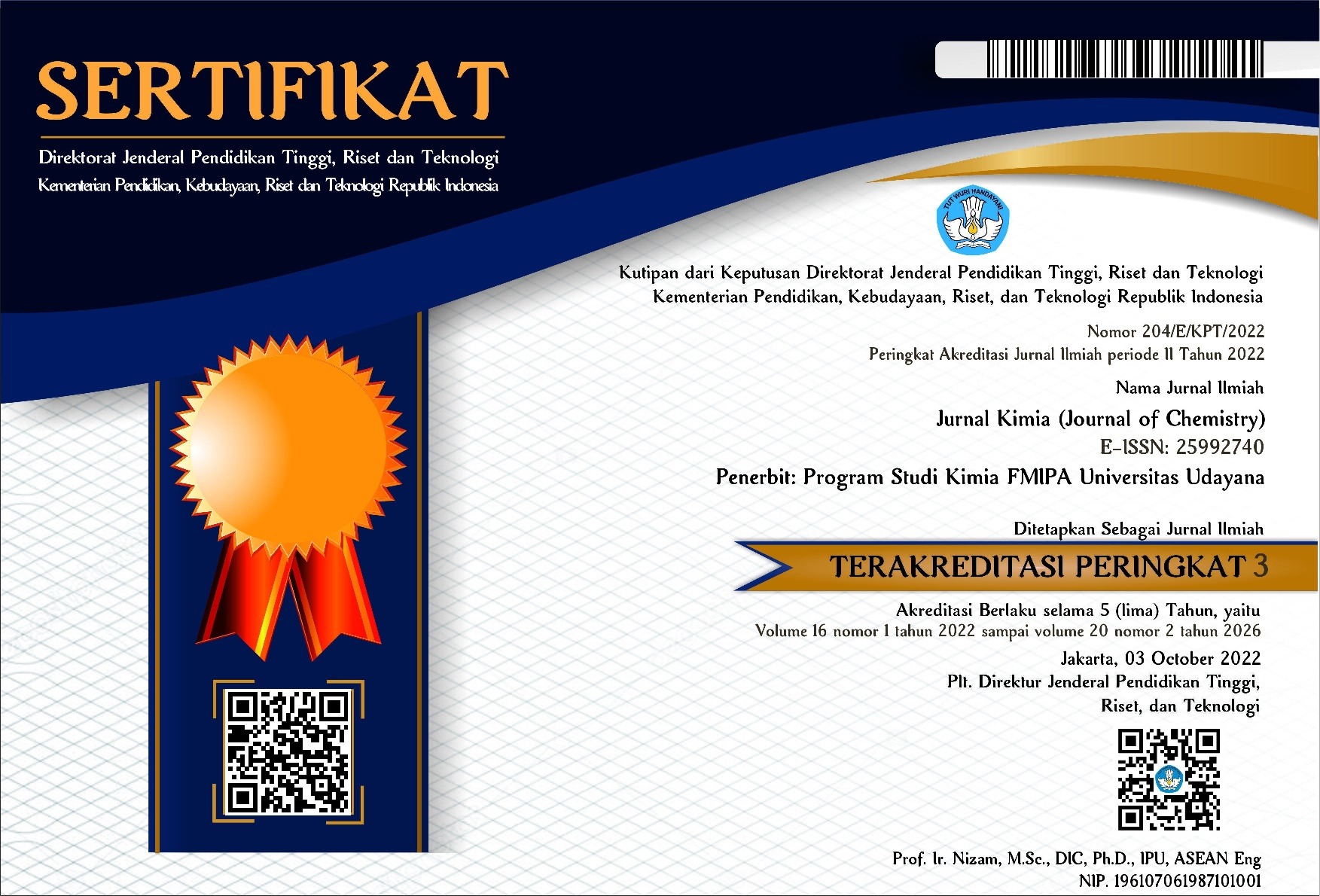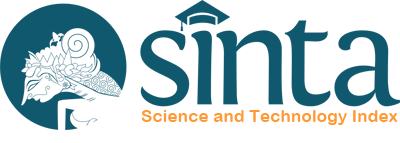DESIGN OF QUINOLINE-CHALCONE HYBRIDS DERIVATIVES AS ANTICANCER USING QSAR AND MOLECULAR DOCKING STUDIES
Abstract
Cancer is a disease caused by abnormal growth of cells that has infected many people worldwide. This reason encourages many scientists to develop medicinal compounds for cancer therapy. One type of drug that has the potential to be developed is based on the quinone-chalcone structure. A method that is highly effective for drug development is the quantitative structure-activity relationship (QSAR) method. In this study, the QSAR problem modeling was developed for quinone-chalcone derivative compounds that have been synthesized previously. Some parameters (descriptors) used in this study were obtained from quantum mechanical modeling with AM1 and ZINDO/S semiempirical methods. The relationship between descriptors and anticancer activity (pIC50) was obtained using the Multiple Linear Regression (MLR) method, so that the QSAR model equation was obtained. This equation has a value of R = 0.998 with Sig = 0.017. Therefore, the equation is valid, and it represents the relationship between descriptors and pIC50. Based on the QSAR equation, four new compound designs were proposed and tested using molecular docking. The results from the pIC50 prediction and molecular docking showed that compound design -12 has the best potential as an anticancer compound.
Keywords: cancer, QSAR, quinone-chalcone, molecular docking
ABSTRAK
Kanker merupakan penyakit yang disebabkan oleh pertumbuhan sel abnormal yang telah menginfeksi banyak orang di seluruh dunia. Alasan tersebut mendorong banyak ilmuwan untuk mengembangkan senyawa obat untuk terapi kanker. Salah satu jenis obat yang berpotensi untuk dikembangkan adalah yang berbasis pada struktur kuinon-kalkon. Salah satu metode yang sangat efektif untuk pengembangan obat adalah metode quantitative structure-activity relationship (QSAR). Dalam penelitian ini, pemodelan masalah QSAR dikembangkan untuk senyawa turunan kuinon-kalkon yang telah disintesis sebelumnya. Beberapa parameter (deskriptor) yang digunakan dalam penelitian ini diperoleh dari pemodelan mekanika kuantum dengan metode semiempiris AM1 dan ZINDO/S. Hubungan antara deskriptor dengan aktivitas antikanker (pIC50) diperoleh dengan menggunakan metode Multiple Linear Regression (MLR), sehingga diperoleh persamaan model QSAR pIC50 = 6,390,17(binding)1,87(LUMO)9,29(qC2)+9,67(qC1)41,02(qC5)9,86(qC14)6,94(qC18). Persamaan ini memiliki nilai R = 0,998 dengan Sig = 0,017. Oleh karena itu, persamaan tersebut valid dan menggambarkan hubungan antara deskriptor dengan pIC50. Berdasarkan persamaan QSAR, empat desain senyawa baru diusulkan dan diuji menggunakan molecular docking. Hasil prediksi pIC50 dan molecular docking menunjukkan bahwa desain senyawa -12 memiliki potensi terbaik sebagai senyawa antikanker.
Kata kunci: kanker, QSAR, kuinon-kalkon, molecular docking
Downloads
References
Álvarez, R. et al. 2016. Pyridine Based Antitumour Compounds Acting at the Colchicine Site. Current medicinal chemistry. 23(11): 1100–30.
Ducki, S., Rennison, D., Woo, M., Kendall, A., Chabert, J.F.D., McGown, A.T. and Lawrence, N.J. 2009. Combretastatin-like chalcones as inhibitors of microtubule polymerization. Part 1: Synthesis and biological evaluation of antivascular activity. Bioorganic & Medicinal Chemistry. 17(22): 7698–7710.
Eberhardt, J., Santos-Martins, D., Tillack, A.F. and Forli, S. 2021. AutoDock Vina 1.2.0: New Docking Methods, Expanded Force Field, and Python Bindings. Journal of Chemical Information and Modeling. 61(8): 3891–3898.
Ferdian, P.R., Elfirta, R.R., Ikhwani, A.Z.N., Kasirah, K., Haerul, H., Sutardi, D. and Ruhiat, G. 2021. Studi In Silico Senyawa Fenolik Madu sebagai Kandidat Inhibitor Mpro SARS-CoV-2. Media Penelitian dan Pengembangan Kesehatan. 31(3): 213–232.
Ferlay J, Ervik M, Lam F, Colombet M, Mery L and Pineros M. 2020. Global Cancer bservatory: Cancer Today.
Hari Narayana Moorthy, N.S., Ramos, M.J. and Fernandes, P.A. 2011. Topological, hydrophobicity, and other descriptors on α-glucosidase inhibition: a QSAR study on xanthone derivatives. Journal of Enzyme Inhibition and Medicinal Chemistry. 26(6): 755–766.
Hou, Q., Lin, X., Lu, X., Bai, C., Wei, H., Luo, G. and Xiang, H. 2020. Discovery of novel steroidal-chalcone hybrids with potent and selective activity against triple-negative breast cancer. Bioorganic and Medicinal Chemistry. 28(23): 1-9.
Li, W., Sun, H., Xu, S., Zhu, Z. and Xu, J. 2017. Tubulin inhibitors targeting the colchicine binding site: a perspective of privileged structures. Future Medicinal Chemistry. 9(15): pp. 1765–1794.
Love, R.R. et al. 2013. Bone mineral density following surgical oophorectomy and tamoxifen adjuvant therapy for breast cancer. Cancer. 119(21): 3746–3752.
Luo, Y. et al. 2021. Synthesis and biological evaluation of novel ligustrazine-chalcone derivatives as potential anti-triple negative breast cancer agents. Bioorganic and Medicinal Chemistry Letters. 47. 1-10.
Mirzaei, S., Hadizadeh, F., Eisvand, F., Mosaffa, F. and Ghodsi, R. 2020. Synthesis, structure-activity relationship and molecular docking studies of novel quinoline-chalcone hybrids as potential anticancer agents and tubulin inhibitors. Journal of Molecular Structure. 1202: 1-13.
Moore, J., Yousef, M. and Tsiani, E. 2016. Anticancer Effects of Rosemary (Rosmarinus officinalis L.) Extract and Rosemary Extract Polyphenols. Nutrients. 8(11): 731-762.
Su, Q.-G., Liu, Y., Cai, Y.-C., Sun, Y.-L., Wang, B. and Xian, L.-J. 2011. Anti-tumour effects of xanthone derivatives and the possible mechanisms of action. Investigational new drugs. 29(6): 1230–40.
Syahri, J., Hidayah, N., Hilma, R., Nurohmah, B.A. and Yuanita, E. 2020. Design of New 2,4-Substituted Furo [3,2-B] Indole Derivatives as Anticancer Compounds Using Quantitative Structure-Activity Relationship (QSAR) and Molecular Docking. Molekul. 15(1): 9-17
Tim Website Dinkes. 2023. Hari Kanker Sedunia 2023 Kota Yogyakarta : “Close the Care Gap.”
Trott, O. and Olson, A.J. 2009. AutoDock Vina: Improving the speed and accuracy of docking with a new scoring function, efficient optimization, and multithreading. Journal of Computational Chemistry. 455-461.
Tseng, C.-H., Tzeng, C.-C., Hsu, C.-Y., Cheng, C.-M., Yang, C.-N. and Chen, Y.-L. 2015. Discovery of 3-phenylquinolinylchalcone derivatives as potent and selective anticancer agents against breast cancers. European Journal of Medicinal Chemistry. 97: 306–319.
World Health Organization. 2022. Cancer.
Yakes, F.M. et al. 2011. Cabozantinib (XL184), a novel MET and VEGFR2 inhibitor, simultaneously suppresses metastasis, angiogenesis, and tumor growth. Molecular cancer therapeutics. 10(12): 2298–308.
Zhang, E.-H., Wang, R.-F., Guo, S.-Z. and Liu, B. 2013. An Update on Antitumor Activity of Naturally Occurring Chalcones. Evidence-Based Complementary and Alternative Medicine 2013. 1–22.

This work is licensed under a Creative Commons Attribution 4.0 International License






